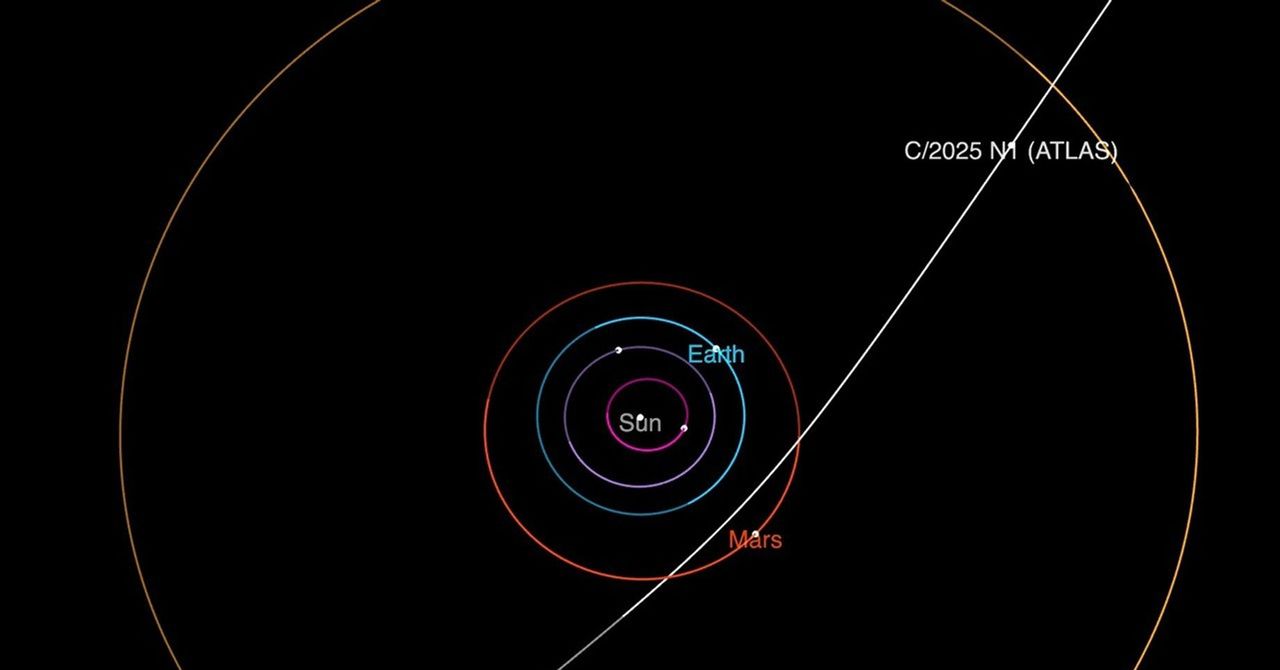On July 2,NASArevealed the existence of 3I/ATLAS, only the third ever interstellar object observed in the universe. These are objects that exist in interstellar space—the areas between stars—and which are not gravitationally bound to any star. The two other interstellar objects discovered to date are the comets 1I/ʻOumuamua and 2I/Borisov.
3I/ATLAS was discovered on July 1, when its existence was reported by a telescope at Rio Hurtado in Chile, operated by theAsteroid Terrestrial Impact Alert System. Known commonly as ATLAS, this is a NASA-funded system developed and operated by the University of Hawaii to detectasteroidsthat could potentially hit Earth. It uses four telescopes—two in Hawaii, one in Chile, and one in South Africa—to automatically scan the entire sky several times each night to monitor celestial movements.
An illustration of 1I/ʻOumuamua, which was the first ever interstellar object discovered in October 2017. It is thought to be up to 400 meters long and cigar-shaped.
An image of 2I/Borisov, the second interstellar object discovered in August 2019. It is thought to be about 975 meters in diameter and moving at 177,000 km/h.
Archived data collected in the preceding weeks by ATLAS' three other telescopes, as well as by the Zwicky Sky Facility at the Palomar Observatory, operated by the California Institute of Technology, confirmed the discovery. Additional observations of 3I/ATLAS were then made by numerous telescopes around the world, gradually revealing more details about it.
Observations of 3I/ATLAS taken by the ATLAS telescope in Chile.
3I/ATLAS is estimated to be, at most, about 20 kilometers in size. It is currently located about 670 million kilometers from the sun and is approaching our star from the direction of Sagittarius at a speed of about 61 km per second. Its speed is expected to increase as it approaches the sun.
When astronomers studied its orbit, they found that 3I/ATLAS was moving too fast to be bound by the sun’s gravity and so will head straight through the solar system and into interstellar space, never to be seen again.
An animation of 3I/ATLAS created using observations made by the ATLAS telescope at Rio Ultado in Chile.
Generally, celestial bodies are named after their discoverers, but in the case of 3I/ATLAS, it was named after the ATLAS research team. The “I” stands for “interstellar,” indicating that the object came from outside the solar system; the “3” was added to the name because it is the third interstellar object discovered.
The object was was uncovered because ATLAS initially identified it as something that might be on a possible collision path with Earth, but NASA says there is no risk of the object hitting our planet. Even when 3I/ATLAS is closest to Earth, it will be about 240 million kilometers away.
An animation of 3I/ATLAS observations made on July 2 by astronomers at the Near Earth Object Coordination Center, a division of the Planetary Defence Office of the European Space Agency.
3I/ATLAS will be visible using ground-based telescopes until September. It will then enter the inner orbit of Mars in late October and will be hidden in the sun’s shadow when it passes our star at its closest point, making it impossible to observe from Earth. However, it will reappear from the sun’s shadow in early December and become visible again.
3I/ATLAS is an active comet, which means that as it gets close to the sun and heats up, the ice in its nucleus could sublimate and form a nebula-like cloud of gas and dust called a coma—otherwise known as a tail.
Because 3I/ATLAS is an object that came from outside the solar system, it may provide valuable data about objects that exist in the further reaches of space. For this reason, astronomers around the world are now paying close attention to it.
This story originally appeared onWIRED Japanand has been translated from Japanese.



 Motivational
Motivational 22 Jul, 2025
22 Jul, 2025 Matthew Anderson
Matthew Anderson